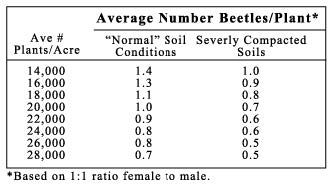
Feb 21, 2017, 9:00 AM
Corn Root Worm
Every year, we see corn root worm issues moving further and further north. Some farmers have been dealing with this for years, while others are just experiencing it for the first time. I don’t see any region as “off limits” to this yield robbing monster. Corn root worm is considered to be the most damaging of all corn pests, causing more than $1 billion in annual lost revenue in North America.
Larval Symptoms of Corn Rootworm
- Progressive feeding on the roots causes difficulty for the plant to take up moisture and nutrients
- A reduced root system can also predispose the corn plant to fall over in wet or windy conditions
- Often this lodging occurs prior to tasseling and the plant attempts to grow upright again, causing a tangled condition known as "goose-necking"
- Injured roots are also easy entry points for fungi and bacteria that may increased severity of root and stalk rots and premature death
- More prevalent in fields corn-on-corn fields
- Besides corn, there is some larval survival on a few grasses including: Foxtail and Miscanthus.
Larval Scouting Methods
Option 1: Washing the Roots and Flotation
- Using a spade or shovel, cut a 7-inch (18 cm) cube of soil around the base of each plant, making certain that the blade of the tool enters the ground vertically to avoid cutting roots. Lift the plant and soil out of the ground and place the soil and root sample in a pail of water to extract the rootworms. The rootworms will float to the top and can be counted. The addition of salt to the water will float the worms to the top more easily.
- Threshold: 5 or more rootworm larvae/plant may signal the need for rootworm larval control.
Option 2: Hand-Sorting of Soil
- Using a spade or shovel, cut a 7-inch (18 cm) cube of soil around the base of each plant, making certain that the blade of the tool enters the ground vertically to avoid cutting roots. Lift the plant and soil out of the ground and place them on a small piece of dark canvas or plastic. Slowly break the soil away from the roots and carefully examine the soil and roots for larvae. The dark background will make it easier to find any of the small white rootworms.
- Threshold: Two or more rootworm larvae/plant may signal the need for rootworm larval control.
Determining Potential for Larval Problem in Next Year's Corn
Two randomly selected plants in each of at least 20 areas of the field should be checked. As you carefully approach each plant, watch for and record any rootworm beetles that drop from the plant or fly away. Grasp the silks in one hand to keep any beetles from leaving them while you inspect the remainder of the plant. After sampling the whole plant, slowly open your hand and count the number of beetles on or within the silks. Examine the silks thoroughly since beetles may be deep in the ear tip area. If there is a second ear on the plant, look through it’s silk as well. Repeat the procedure for the second plant that is within 10 feet of the first plant. After sampling all plants, determine the average number of beetles per plant.
Conduct beetle counts in fields planted to corn consecutively for two or more years. Next season, rotate to another crop or treat for rootworm larvae at cultivation or planting, if the average beetle count per plant equals or exceeds the number listed below for your average number of plants per acre.
Chart 1: Treatment Threshold Chart for In-Season Beetle Counts

Information and chart source: https://extension.entm.purdue.edu/fieldcropsipm/insects/corn-rootworms.php
Appendix A: Examples from the field
Example of larvae.
Example of infected ear of corn with corn root worm beetles.
Right plant shows healthy root system. Left plant shows weak, small root system of a corn root worm infected plant.
Example of “goosenecked corn” that’s blown over and then begun to try and regrow upright.

